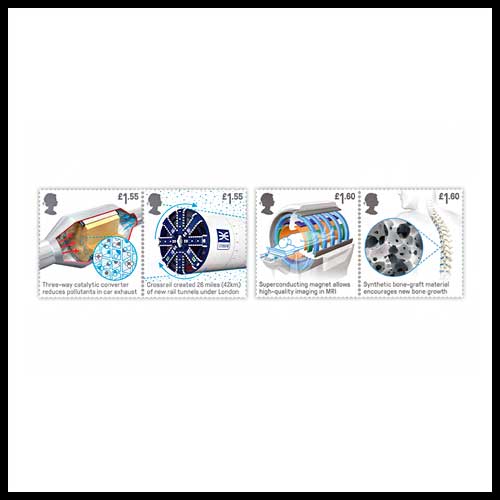Stamps Celebrate 50 Years of British Engineering
2019-05-07 Tue
Royal Mail issued a set of 10 stamps on 2nd May to celebrate British engineering innovations in the last 50 years. Six of them are issued as 3 se-tenant pairs while four of them are issued in a souvenir sheet. Royal Mail and Royal Academy of Engineering worked together to finalise the stamp designs.The first-class Raspberry Pi stamp has a text which reads “microcomputer helps to teach programming”. The micro-PC can be used to control a wide range of applications, video games, robots and machines. It is built on a single circuit board and 20 million pieces have been sold since 2012.
The text on a first-class stamp reads “The Falkirk Wheel rotating boat lift connects two Scottish waterways”. The Falkirk Wheel is the world’s first and only rotating boat lift, vertically connecting the Forth and Clyde Canal with the Union Canal. The two waterways were once connected by 11 locks but were dismantled in 1933. The British Waterways Board, Arup, Butterley Engineering and RMJM architects came together to reconnect the canals after 70 years with this amazing structure.
A £1.55 stamp features the texts “Three-way catalytic converter reduces pollutants in car exhaust”. The catalytic converter turns carbon monoxide, hydrocarbons and oxides of nitrogen into carbon dioxide, water and nitrogen, respectively. They prevent almost 20 million tonnes of pollutants from entering the atmosphere.
Another £1.55 stamp features the text “Crossrail created 26 miles (42km) of new rail tunnels under London". A new 60-mile railway line through London called Crossrail is being built currently. The tunneling began in 2013 and was completed in 2015. Eight 1,000-ton tunneling machines operated by 20 workers excavated 3.4 million tons of earth in three years. The excavated material was used for building the Wallasea Island Wild Coast Project in Essex.
A £1.60 stamp features an MRI machine with text “Superconducting magnet allows high-quality imaging in MRI”. The non-invasive technique used powerful superconducting magnets in the 1960s. In the 1970s, it was applied to body scanning by Sir Martin Wood of Oxford Instruments. British scientist William Sturgeon invented the first electromagnet in 1824 which is largely used even today.
One of the £1.60 stamps reads, “Synthetic bone-graft material encourages new bone growth”. Karin Hing and her team at Queen Mary University, London developed bone-graft substitutes. She also received the Royal Academy of Engineering’s silver medal in 2011 for achieving this feat.
The stamps are printed in sheets of 60 and sold in panes of 30. International Security Printers printed the souvenir sheet and stamps by lithography. The stamps were designed by Common Curiosity studio and illustrated by Martin Woodward.
Turner Duckworth design firm created the souvenir sheet designs. The Harrier GR-3 photographs were taken by Richard Cooke. The aircraft is shown in a short take-off position on the first-class stamp, in a conventional flight position on another first-class stamp, a transition to landing position on the £1.55 stamp and in a vertical landing position on the £1.55 stamp. Blueprints of the aircraft and text “Harrier Jump Jet 50th Anniversary” are featured on the selvage.
Developed in the 1960s by Hawker Siddeley, the jet was operational for 40 years since its deployment with the Royal Air Force in 1969. Several other countries are also using this and later versions of this jump jet.
First-day covers; 11 postcards with similar designs; and a presentation pack with the six stamps and the souvenir sheet are also available.
Visit philamart to view and purchase variety of stamps from all over the world.
Image Courtesy: The Royal Mail
Latest News
-
Panchala King Bhanumitra Copper Coin
2024-04-26 FriThe Panchala kingdom was ruled by the Mitra kings. The Mitra kings are known to issue coins and most...
-
Mahatma
2024-04-25 ThuIndia Post issued a commemorative postage stamp on #LalaHansraj, also known as Mahatma Hansraj for�...
-
Berar Mint of Muhammad Akbar
2024-04-25 ThuBerar was a kingdom located in the Deccan region, with Elichpur as its capital. It was one of the Su...
-
Janma Kalnayak of Bhagwan Mahavir
2024-04-24 WedOn 21st April 2024 which was the 2550th Janma Kalnyanak of Bhagwan Mahavir Swami, PM Modi unveile...
-
Gold Pagoda of Vijaynagar Empire King Deva Raya I
2024-04-10 WedKing Deva Raya I of the Vijayanagara Empire was a patron of Kannada literature and architecture. He ...

